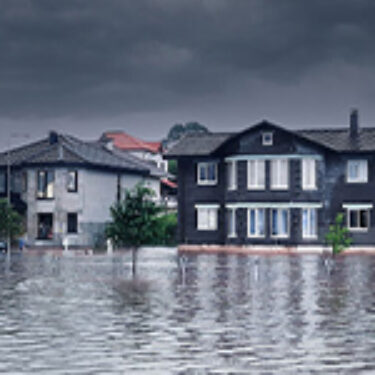According to the U.S. Federal Emergency Management Agency (FEMA), a single inch of water in a home can cause $25,000 in flood damage; nevertheless, many homeowners remain uninsured. Brad Turner, National Product Manager, Flood, Burns & Wilcox, Morehead City, North Carolina, explains the widespread need for Flood Insurance and how it helps protect homeowners.
What are the biggest flood-related risks facing homeowners today?
B.T.: Extreme weather related to climate change has made flooding more frequent. A standard Homeowner’s Insurance policy does not cover flood in the U.S. Additionally, most homeowners purchase Flood Insurance only if required by their mortgage company—typically, this is only when their home is located in a high-risk zone on FEMA flood maps.

Brokers should be comfortable talking about Flood Insurance and its associated policy forms. Knowing how Flood Insurance coverage can help each individual homeowner is what puts a good broker ahead of the pack.
Lower risk zones are expected to flood once every 500 years; however, what we are seeing is a gradual trend upwards. The National Flood Insurance Program (NFIP) says 20 percent of its claims are for damaged properties in low- and moderate-risk flood zones. That is now trending closer to 30 percent. The FEMA flood maps that dictate these zones are not updated frequently enough—some are 5 to 10 years old. Climate change means sea levels are rising and there are more frequent weather events. Also, when an area develops quickly and vegetation is removed, there is less drainage and greater risk for flooding. Concrete provides less drainage than soil or vegetation. So, urbanization is a big contributing factor to low- and moderate- flood risk zones starting to experience a higher incidence of flooding.
What should homeowners be aware of relative to these risks?
B.T.: With the NFIP, homeowners can only get $250,000 for the actual structure and $100,000 for the contents of their home if it is damaged in a flood. The owner of a home worth $1 million or more could obviously exceed those limits by a considerable margin. Relying upon a mortgage company to dictate the need for Flood Insurance coverage—or the limits for that coverage—is extremely risky. It is a huge financial gamble to be uninsured or underinsured when it comes to flood damage.
Investing in Flood Insurance coverage is always a good rule of thumb, as is partnering with an insurance broker or agent who is an expert in Flood Insurance and familiar with flood risk in general. There are a lot of private market tools available that can be used to evaluate the potential flood risks for a particular location. These tools take historical data and climate change into account in order to predict what the likelihood of flooding is and allow homeowners to make informed decisions on their needs for Flood Insurance.
What else should homeowners know about Flood Insurance?
B.T.: Flood Insurance can offer extended limits so homeowners can get full coverage for the entirety of their home and its contents. Indirect loss should also be considered. For example, if a homeowner’s primary residence is uninhabitable following a flood, there are costs associated with residing elsewhere while the home is being repaired. Expenses related to indirect loss are not covered by the NFIP; however, Flood Insurance does have the option for this coverage, to mitigate costs such as renting one or several rooms in a hotel, dining out and other living expenses. Also, the NFIP sometimes does not provide coverage based on the replacement cost of a home and homeowners may have to contend with a depreciation in value. With Flood Insurance, there are coverage options available that are based on the current cost to replace a home.
What limitations and exclusions should policyholders be aware of?
B.T.: The definition of what is considered a flood event does vary from market to market. Sometimes two or more properties must be affected, while in other circumstances the definition is broader. There are also certain areas of a home where contents may be excluded from coverage, such as a basement.
What can homeowners do from a prevention standpoint to complement Flood Insurance?
B.T.: In some places, flood vents or breakaway walls are an option. Adding flood vents to a garage, for example, allows water to flow through the garage. While it does expose that particular enclosure to water, it lessens the pressure created as well as the potential for floodwater to knock over the home. That can help to prevent a catastrophic loss. Homes can also be elevated. When there is a risk of imminent flooding, many Flood Insurance policies will allow expenses for things like sandbags to help prevent water from entering a home. Proper construction is the most important factor in mitigating flood damage, so it should be considered carefully when buying a property.
What are the biggest opportunities for brokers in Flood Insurance?
B.T.: The brokers I see who are the most successful with Flood Insurance are consistently offering it to every client they encounter. They have a dialogue with clients about the need for Flood Insurance. Successful brokers are also partnering with an expert in Flood Insurance who has the tools available to provide them with context and customized, informed risk assessments. That kind of information adds value to the conversation brokers can have with their clients. Brokers should be comfortable talking about Flood Insurance and its associated policy forms. Knowing how Flood Insurance coverage can help each individual homeowner is what puts a good broker ahead of the pack.
FLOOD INSURANCE
- WHY YOUR CLIENTS MIGHT NEED IT: Climate change has increased the frequency and severity of flood events, including in areas that previously were at low or moderate risk for flooding.
- PROTECTS AGAINST: There can be prohibitive costs associated with repairing or replacing a residence and its contents following a flood, which is not a covered peril under standard Homeowners Insurance policies.
- EXPERT OPINION: “Relying upon a mortgage company to dictate the need for Flood Insurance coverage—or the limits for that coverage—is extremely risky. It is a huge financial gamble to be uninsured or underinsured when it comes to flood damage,” said Brad Turner, National Product Manager, Flood, Burns & Wilcox, Morehead City, North Carolina.
Click here to learn more about this policy.





